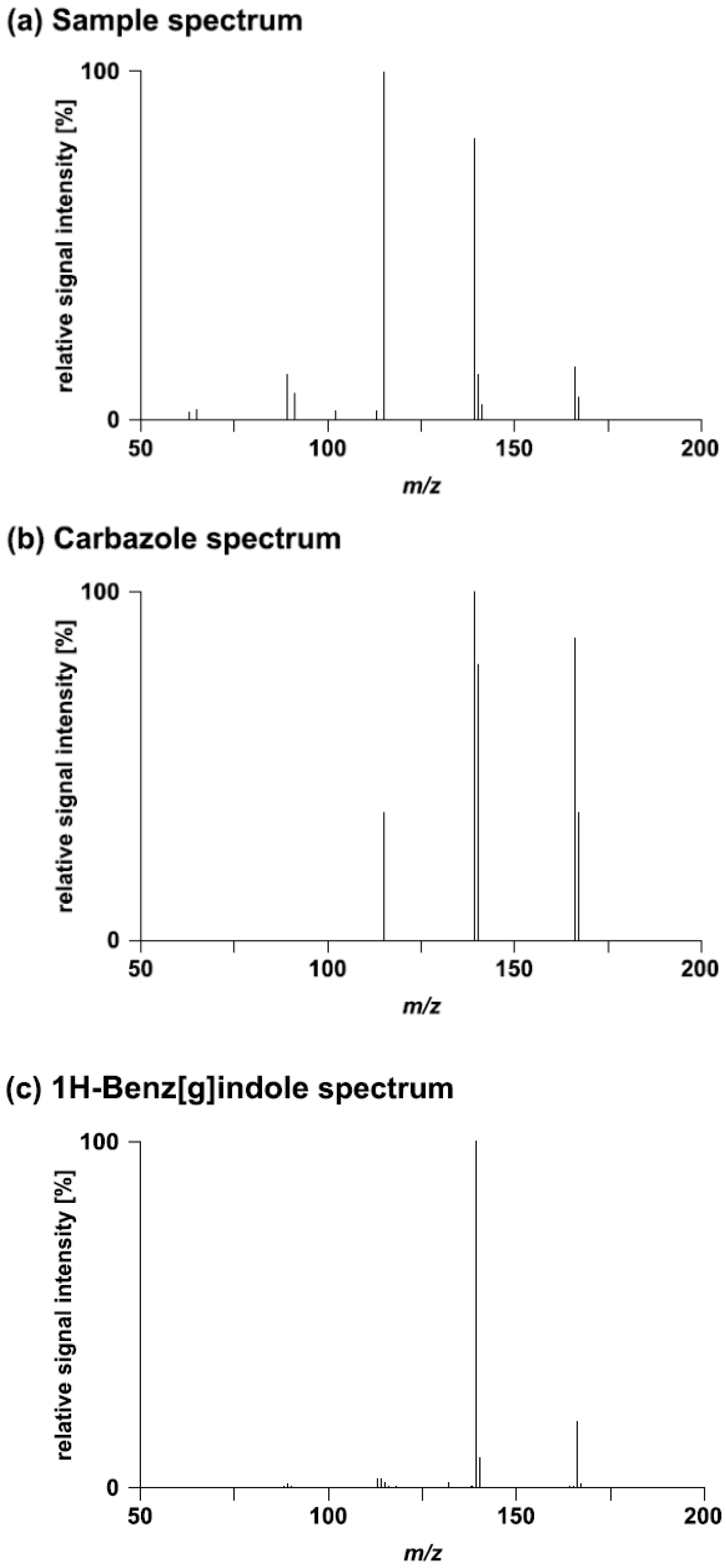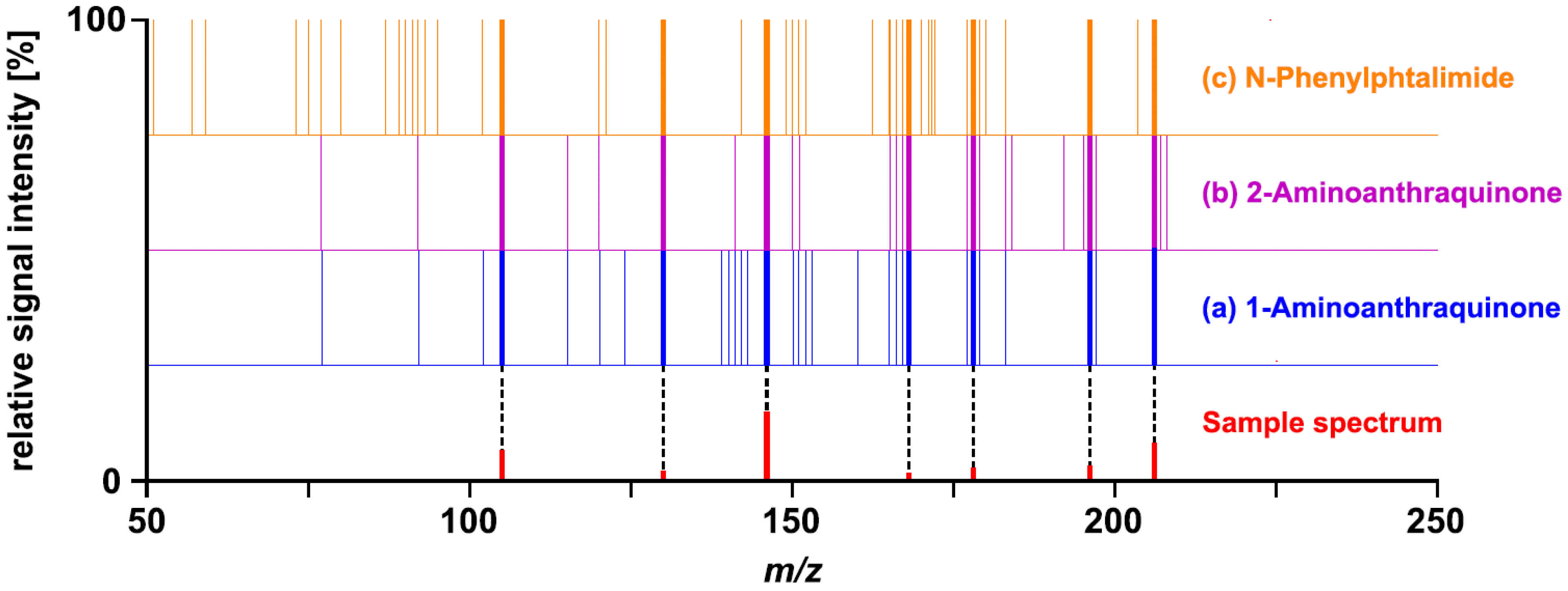Applying Tandem Mass Spectral Libraries for Solving the Critical Assessment of Small Molecule Identification (CASMI) LC/MS Challenge 2012
Abstract
:1. Introduction
2. Results and Discussion
| Challenge | Matched compound(s) | Library | Score | Correct compound |
|---|---|---|---|---|
| 1 | Kanamycin A | MassBank, NIST MS/MS 2012, Wiley Registry MS/MS | 1.0 | Kanamycin A |
| 10 | N-Phenylphthalimide | Wiley Registry | 1.0 | 1-Aminoanthraquinone |
| 2-Aminoanthraquinone | MS/MS | 0.84 | ||
| 13 | Benzyldiphenylphosphine oxide | MassBank | 1.0 | Benzyldiphenylphosphine oxide |
| 14 | Carbazole | MassBank | 1.0 | 1H-Benz[g]indole |
| 1H-benz[g]indole | 0.99 | |||
| 15 | 1-Isopropyl-5-methyl-1H-indole-2,3-dione | MassBank | 1.0 | 1-Isopropyl-5-methyl-1H-indole-2,3-dione |
2.1. MassBank Results
| Challenge | CE | Matched compound(s) | Accession | Score |
|---|---|---|---|---|
| 1 | 10 eV | Kanamycin A (2nd place in hit list) | KO009014 | 0.733 |
| 20 eV | Kanamycin A | KO009015 | 0.874 | |
| 30 eV | Kanamycin A (2nd place in hit list) | KO009015 | 0.773 | |
| 13 | 25% | Benzyldiphenylphosphine oxide | UF011001 | 0.986 |
| 45% | Benzyldiphenylphosphine oxide | UF011003 | 0.995 | |
| HCD 45 | Benzyldiphenylphosphine oxide | UF011007 | 0.996 | |
| HCD 75 | Benzyldiphenylphosphine oxide | UF011009 | 0.967 | |
| 14 | HCD 120 | Carbazole (2nd place in hit list) | UF026312 | 0.807 |
| 1H-Benz[g]indole (7th place in hit list) | UF011409 | 0.725 | ||
| HCD 180 | Carbazole | UF026314 | 0.819 | |
| 1H-Benz[g]indole (3rd place in hit list) | UF011413 | 0.801 | ||
| 15 | HCD 120 | 1-Isopropyl-5-methyl-1H-indole-2,3-dione | UF011512 | 0.968 |
| HCD 90 | 1-Isopropyl-5-methyl-1H-indole-2,3-dione | UF011510 | 0.971 |

2.2. NIST MS/MS 2012 Results
| Challenge | CE | Matched compound | MF | RMF | Prob |
|---|---|---|---|---|---|
| 1 | 10 eV | Kanamycin A | 645 | 879 | 98.88 |
| 20 eV | Kanamycin A | 501 | 833 | 98.81 | |
| 30 eV | Kanamycin A | 531 | 776 | 98.66 |
2.3. METLIN Results
2.4. Wiley Registry MS/MS Results
2.4.1. Search Results with the Published Library
| Challenge | CE | Matched compound(s) | ramp | m/z | Delta |
|---|---|---|---|---|---|
| 1 | 10 eV | Tobramycin | 72.03 | 468.2665 | 16.9788 |
| 20 eV | Tobramycin | 68.43 | 468.2665 | 16.9788 | |
| 30 eV | Tobramycin | 65.85 | 468.2665 | 16.9788 | |
| 10 | 35% | N-Phenylphthalimide (1st place in hit list) | 54.1 | 224.0707 | 0.0004 |
| 2-Aminoanthraquinone (2nd place in hit list) | 45.6 | 224.0707 | 0.0004 |
2.4.1. Search Results with the Extended Library
| Challenge | CE | Matched compound(s) | ramp | m/z | Delta |
|---|---|---|---|---|---|
| 1 | 10 eV | Kanamycin A | 98.84 | 485.2454 | -0.0001 |
| 20 eV | Kanamycin A | 98.46 | 485.2454 | -0.0001 | |
| 30 eV | Kanamycin A | 98.46 | 485.2454 | -0.0001 | |
| 10 | 35% | N-Phenylphthalimide (1st place in hit list) | 36.05 | 224.0707 | 0.0004 |
| 1-Aminoanthraquinone (2nd place in hit list) | 33.37 | 224.0707 | 0.0004 | ||
| 2-Aminoanthraquinone (3rd place in hit list) | 30.39 | 224.0707 | 0.0004 | ||
| 13 | 25% | Benzyldiphenylphosphine oxide | 81.58 | 293.1090 | 0.0007 |
| 45% | Benzyldiphenylphosphine oxide | 91.53 | 293.1090 | 0.0007 | |
| HCD 45 | Benzyldiphenylphosphine oxide | 84.05 | 293.1090 | 0.0007 | |
| HCD 75 | Benzyldiphenylphosphine oxide | 83.25 | 293.1090 | 0.0007 | |
| 14 | HCD 120 | 1H-Benz[g]indole (1st place in hit list) | 80.30 | 168.0808 | -0.0004 |
| Carbazole (2nd place in hit list) | 18.86 | 168.0808 | -0.0004 | ||
| HCD 180 | 1H-Benz[g]indole (1st place in hit list) | 67.04 | 168.0808 | -0.0004 | |
| Carbazole (2nd place in hit list) | 30.91 | 168.0808 | -0.0004 |

3. Experimental Section
3.1. MassBank
3.2. NIST MS/MS 2012
3.3. METLIN
3.4. Wiley Registry MS/MS
4. Conclusions
Acknowledgments
Conflict of Interest
References
- Stein, S. Mass spectral reference libraries: An ever-expanding resource for chemical identification. Anal. Chem. 2012, 84, 7274–7282. [Google Scholar] [CrossRef]
- Marquet, P.; Saint-Marcoux, F.; Gamble, T.N.; Leblanc, J.C. Comparison of a preliminary procedure for the general unknown screening of drugs and toxic compounds using a quadrupole-linear ion-trap mass spectrometer with a liquid chromatography-mass spectrometry reference technique. J. Chromatogr. B 2003, 789, 9–18. [Google Scholar] [CrossRef]
- Smith, C.A.; O’Maille, G.; Want, E.J.; Qin, C.; Trauger, S.A.; Brandon, T.R.; Custodio, D.E.; Abagyan, R.; Siuzdak, G. METLIN: a metabolite mass spectral database. Ther. Drug Monit. 2005, 27, 747–751. [Google Scholar] [CrossRef]
- Milman, B.L. Towards a full reference library of MS(n) spectra. Testing of a library containing 3126 MS2 spectra of 1743 compounds. Rapid Commun. Mass Spectrom. 2005, 19, 2833–2839. [Google Scholar] [CrossRef]
- Pavlic, M.; Libiseller, K.; Oberacher, H. Combined use of ESI-QqTOF-MS and ESI-QqTOF-MS/MS with mass-spectral library search for qualitative analysis of drugs. Anal. Bioanal. Chem. 2006, 386, 69–82. [Google Scholar] [CrossRef]
- Oberacher, H.; Pavlic, M.; Libiseller, K.; Schubert, B.; Sulyok, M.; Schuhmacher, R.; Csaszar, E.; Kofeler, H.C. On the inter-instrument and the inter-laboratory transferability of a tandem mass spectral reference library: 1. Results of an Austrian multicenter study. J. Mass Spectrom. 2009, 44, 485–493. [Google Scholar]
- Oberacher, H.; Pavlic, M.; Libiseller, K.; Schubert, B.; Sulyok, M.; Schuhmacher, R.; Csaszar, E.; Kofeler, H.C. On the inter-instrument and the inter-laboratory transferability of a tandem mass spectral reference library: 2. Optimization and characterization of the search algorithm. J. Mass Spectrom. 2009, 44, 494–502. [Google Scholar] [CrossRef]
- Dresen, S.; Gergov, M.; Politi, L.; Halter, C.; Weinmann, W. ESI-MS/MS library of 1,253 compounds for application in forensic and clinical toxicology. Anal. Bioanal. Chem. 2009, 395, 2521–2526. [Google Scholar] [CrossRef]
- Horai, H.; Arita, M.; Kanaya, S.; Nihei, Y.; Ikeda, T.; Suwa, K.; Ojima, Y.; Tanaka, K.; Tanaka, S.; Aoshima, K.; et al. MassBank: a public repository for sharing mass spectral data for life sciences. J. Mass Spectrom. 2010, 45, 703–714. [Google Scholar] [CrossRef]
- Wissenbach, D.K.; Meyer, M.R.; Remane, D.; Philipp, A.A.; Weber, A.A.; Maurer, H.H. Drugs of abuse screening in urine as part of a metabolite-based LC-MSn screening concept. Anal. Bioanal. Chem. 2011, 400, 3481–3489. [Google Scholar] [CrossRef]
- Broecker, S.; Herre, S.; Wust, B.; Zweigenbaum, J.; Pragst, F. Development and practical application of a library of CID accurate mass spectra of more than 2,500 toxic compounds for systematic toxicological analysis by LC-QTOF-MS with data-dependent acquisition. Anal. Bioanal. Chem. 2011, 400, 101–117. [Google Scholar] [CrossRef]
- Rojas-Cherto, M.; Peironcely, J.E.; Kasper, P.T.; van der Hooft, J.J.; de Vos, R.C.; Vreeken, R.; Hankemeier, T.; Reijmers, T. Metabolite identification using automated comparison of high-resolution multistage mass spectral trees. Anal. Chem. 2012, 84, 5524–5534. [Google Scholar] [CrossRef]
- Zhang, K.; Wong, J.W.; Yang, P.; Hayward, D.G.; Sakuma, T.; Zou, Y.; Schreiber, A.; Borton, C.; Nguyen, T.V.; Kaushik, B.; et al. Protocol for an electrospray ionization tandem mass spectral product ion library: development and application for identification of 240 pesticides in foods. Anal. Chem. 2012, 84, 5677–5684. [Google Scholar] [CrossRef]
- Oberacher, H.; Weinmann, W.; Dresen, S. Quality evaluation of tandem mass spectral libraries. Anal. Bioanal. Chem. 2011, 400, 2641–2648. [Google Scholar] [CrossRef]
- Oberacher, H.; Pitterl, F.; Siapi, E.; Steele, B.R.; Letzel, T.; Grosse, S.; Poschner, B.; Tagliaro, F.; Gottardo, R.; Chacko, S.A.; et al. On the inter-instrument and the inter-laboratory transferability of a tandem mass spectral reference library. 3. Focus on ion trap and upfront CID. J. Mass Spectrom. 2012, 47, 263–270. [Google Scholar]
- Wurtinger, P.; Oberacher, H. Evaluation of the performance of a tandem mass spectral library with mass spectral data extracted from literature. Drug Test. Analysis 2012, 4, 235–241. [Google Scholar] [CrossRef]
- NIST/EPA/NIH Mass Spectral Library with Search Program (Data Version: NIST 11, Software Version 2.0g). Available online: http://www.nist.gov/srd/nist1a.cfm#/ (accessed on 16 April 2013).
- Oberacher, H. Wiley Registry of Tandem Mass Spectral Data, MS for ID; John Wiley & Sons Inc: Hoboken, NJ, USA, 2012. [Google Scholar]
- Tautenhahn, R.; Cho, K.; Uritboonthai, W.; Zhu, Z.; Patti, G.J.; Siuzdak, G. An accelerated workflow for untargeted metabolomics using the METLIN database. Nat. Biotechnol. 2012, 30, 826–828. [Google Scholar]
- Pavlic, M.; Schubert, B.; Libiseller, K.; Oberacher, H. Comprehensive identification of active compounds in tablets by flow-injection data-dependent tandem mass spectrometry combined with library search. Forensic Sci. Int. 2010, 197, 40–47. [Google Scholar] [CrossRef]
- Oberacher, H.; Schubert, B.; Libiseller, K.; Schweissgut, A. Detection and identification of drugs and toxicants in human body fluids by liquid chromatography-tandem mass spectrometry under data-dependent acquisition control and automated database search. Anal. Chim. Acta. 2013, 770, 121–131. [Google Scholar] [CrossRef]
- Schubert, B.; Pavlic, M.; Libiseller, K.; Oberacher, H. Unraveling the metabolic transformation of tetrazepam to diazepam with mass spectrometric methods. Anal. Bioanal. Chem. 2008, 392, 1299–1308. [Google Scholar] [CrossRef]
- PubChem Compound Database. Available online: http://pubchem.ncbi.nlm.nih.gov/ (accessed on 23 December 2012).
- Critical Assessment of Small Molecule Identification (CASMI). Available online: http://casmi-contest.org/ (accessed on 22 December 2012).
- Mass Bank Spectrum Search. Available online: http://www.massbank.jp/SearchPage.html/ (accessed 7 January 2013).
- Stein, S.E. Estimating probabilities of correct identification from results of mass spectral library searches. J. Am. Soc. Mass Spectrom. 1994, 5, 316–323. [Google Scholar]
- METLIN MS/MS Spectrum Search. Available online: http://metlin.scripps.edu/spec_search.php/ (accessed on 9 January 2013).
- Wiley Registry of Tandem Mass Spectral Data, MS for ID. Available online: http://www.msforid.com/ (accessed on 9 January 2013).
- Oberacher, H.; Whitley, G.; Berger, B. Evaluation of the sensitivity of the “Wiley Registry of Tandem Mass Spectral Data, MSforID” with MS/MS data of the “NIST/NIH/EPA Mass Spectral Library”. J. Mass Spectrom. 2013, 48, 487–496. [Google Scholar] [CrossRef]
Supplementary Files
© 2013 by the authors; licensee MDPI, Basel, Switzerland. This article is an open access article distributed under the terms and conditions of the Creative Commons Attribution license (http://creativecommons.org/licenses/by/3.0/).
Share and Cite
Oberacher, H. Applying Tandem Mass Spectral Libraries for Solving the Critical Assessment of Small Molecule Identification (CASMI) LC/MS Challenge 2012. Metabolites 2013, 3, 312-324. https://doi.org/10.3390/metabo3020312
Oberacher H. Applying Tandem Mass Spectral Libraries for Solving the Critical Assessment of Small Molecule Identification (CASMI) LC/MS Challenge 2012. Metabolites. 2013; 3(2):312-324. https://doi.org/10.3390/metabo3020312
Chicago/Turabian StyleOberacher, Herbert. 2013. "Applying Tandem Mass Spectral Libraries for Solving the Critical Assessment of Small Molecule Identification (CASMI) LC/MS Challenge 2012" Metabolites 3, no. 2: 312-324. https://doi.org/10.3390/metabo3020312




